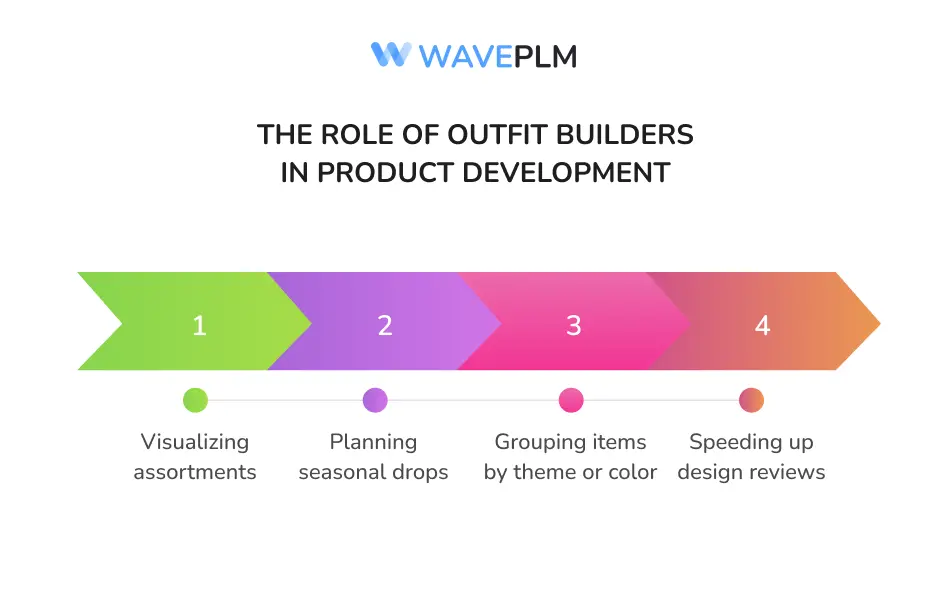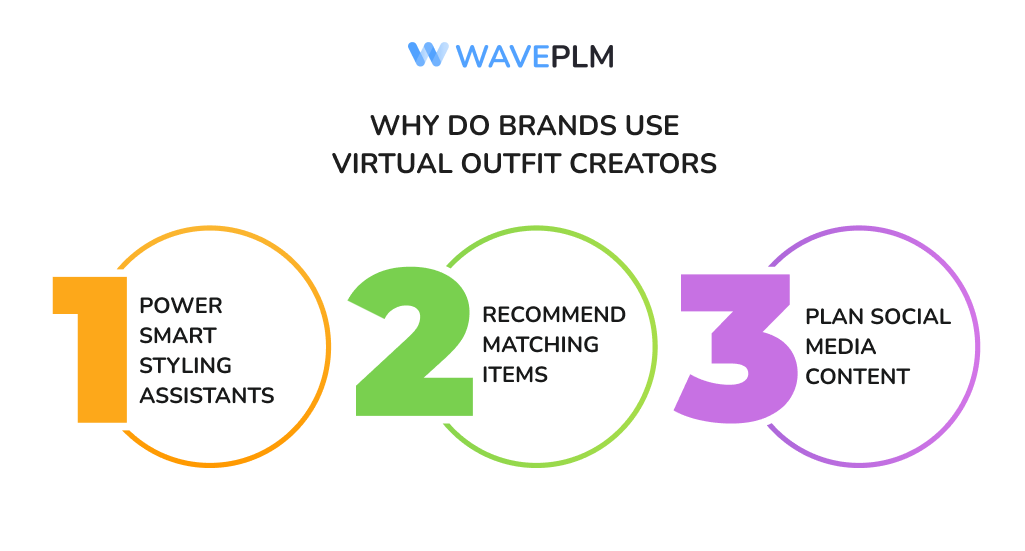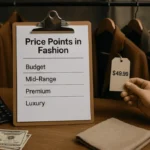
In today’s fast-moving fashion world, consumers want more than just clothes off the rack. They want control, customization, and creativity. Thanks to digital fashion tools like outfit makers, outfit builders, and outfit customizers, they now have it. These tools, combined with PLM software, are transforming how brands design, generate outfits, and deliver style. Developers continuously improve these tools based on user feedback to enhance functionality and user experience.
Introduction to Outfit Maker Tools
Outfit maker tools are innovative digital solutions designed to help users generate stylish outfits and manage their closet items efficiently. These tools provide shopping outfit inspiration, allowing users to create new combinations using their favorite closet items. By utilizing outfit maker tools, individuals can promote fashion sustainability by reducing the need for new purchases and making the most of the clothes they already own. With features like improved outfit generation and user-friendly interfaces, these tools make it easier for users to discover new outfit ideas and feel confident in their fashion choices.
What Is an Outfit Maker?
An outfit maker is a digital tool that lets users create stylish outfits using virtual garments. It generates outfits based on your favourite closet items and helps you build stylish outfits that match your unique style. Unlike paper sketches or flat images, outfit makers show full looks in 3D or on digital avatars. They allow users to try new combinations of clothes without needing physical samples, helping them dress well and feel more confident about their style choices.
Common Features of an Outfit Maker
|
Feature |
Description |
|---|---|
|
Drag-and-drop function |
Easily combine tops, bottoms, and accessories |
|
Virtual try-on |
View how the outfit looks on a digital avatar |
|
Color and fabric options |
Change colors and fabrics to visualize variations |
|
Save/share options |
Export the look or share with others instantly |
|
Gallery images |
Upload images of your clothing items from your personal galleries to create personalized outfit recommendations and assist with closet organization |
These tools are often available in a free app format, making them user friendly and accessible to everyone. They allow you to work with only your clothes or import shoppable items via clothing links and store accounts.
How Outfit Maker Tools Work
Outfit maker tools work by allowing users to upload their closet items, either by taking a photo, using a gallery image, or searching for items on the internet, such as Google Images. The tool then generates outfits based on the uploaded items, creating a personalized shopping experience. Some tools, like Pronti, use AI to learn the user’s style and preferences, providing more accurate and relevant outfit suggestions over time. By analyzing the user’s closet items and shopping behavior, these tools can recommend new pieces that match their unique style, making it easier to build stylish outfits and plan daily adventures.
The Role of Outfit Builders in Product Development
While outfit makers serve consumers, an outfit builder helps fashion teams during product development. It works like a digital wardrobe that lets teams style looks, plan collections, and coordinate matching pieces.
Using outfit builders, brands can:
- Visualize assortments
- Plan seasonal drops
- Group items by theme or color
- Speed up design reviews
Improvements to previously working areas have enhanced the performance and reliability of outfit builders.
This visual planning improves communication between design, merchandising, and marketing teams. It supports fashion sustainability by reducing waste and overproduction.

Outfit Customizers for Personalized Fashion
Customization is one of the biggest trends in retail. An outfit customizer gives shoppers the ability to change a design to fit their taste. Think custom prints, length, sleeve type, and color palette.
This personalized fashion experience increases brand loyalty and reduces return rates. Users feel more connected to pieces they help create, and outfit customizers can recommend items that match the user’s unique style.
Benefits of Offering Custom Clothing Options
|
Benefit |
Impact on Brand |
|---|---|
|
Customer engagement |
Shoppers stay longer and interact more |
|
Unique product appeal |
Each item can be made one-of-a-kind |
|
Lower returns |
Better fit and satisfaction reduce refunds. Custom clothing options have saved time and effort by reducing the need for manual intervention in the customization process. |
|
Brand differentiation |
Stand out in a crowded market with tailored options |
Outfit Planning and Organization
Outfit planning and organization are key features of outfit maker tools. These tools enable users to plan and organize their outfits in advance, using a digital closet to store and manage their clothing items. By creating a virtual representation of their closet, users can easily generate outfits, track what they’ve worn, and discover new combinations of clothes they already own. Some tools also offer features like calendar integration, allowing users to plan outfits for specific events or dates. Additionally, outfit maker tools can help users create a packing list for trips, making it easier to pack and plan outfits for the week.
Virtual Outfit Creators: The Next Step in Digital Fashion
A virtual outfit creator is a more advanced tool. It blends outfit building with 3D rendering, AI, and virtual try-on. Some tools even suggest matching items or generate outfits based on user preferences, allowing users to explore outfit inspirations generated from their own closet or from various retail partners.
For example, users might upload a photo or use google images, and the software builds outfits using available products. Brands use these tools to:
- Power smart styling assistants
- Recommend matching items
- Plan social media content
You can even watch Pronti match your closet items to create looks for your daily adventures. This creates outfits that match your lifestyle, and teaches Pronti your unique style.

User Interface and Experience
The user interface and experience of outfit maker tools are designed to be intuitive and user-friendly. These tools often feature a clean and simple design, making it easy for users to navigate and interact with the platform. By providing a seamless and inspiring experience, outfit maker tools aim to help users achieve their fashion goals without spending too much time getting ready. With features like fast premium methods for uploading items and a better testing suite to prevent bugs, these tools ensure a smooth and efficient user experience. Whether users are looking for outfit ideas, shopping inspiration, or simply a way to organize their closet, outfit maker tools provide a convenient and stylish solution.
Custom Clothing Software and PLM Software Integration
Behind every user-friendly tool is a powerful backend. Custom clothing software links the front-end design tools to the backend production pipeline. PLM software connects it all together.
PLM (Product Lifecycle Management) software stores and manages product data. It allows different teams to collaborate in real time, ensuring each custom outfit is ready for production. Both custom clothing software and PLM software ensure data security and transparency through robust privacy policies.
How PLM Software Supports Outfit Customization
|
PLM Feature |
Role in Custom Fashion |
|---|---|
|
Centralized data |
Store all custom inputs and size charts. Recent improvements in item upload processes have streamlined the customization workflow. |
|
Trigger steps from design to tech pack creation |
|
|
Supplier communication |
Share updated specs with manufacturers instantly |
|
Version control |
Track changes made during customization |
This setup creates a seamless flow from virtual idea to physical product, especially after a massive spring cleaning or closet organization project.
How Pronti Learns Your Style
When you upload all the items in your closet, teach Pronti your likes and dislikes. Over time, Pronti learns how to recommend new combinations that reflect your unique style. It’s like having a stylist who works with just mine wardrobe.
Teach Pronti what to prioritize—comfort, elegance, casual or business—and it creates outfits that make you feel confident.
Use Cases Across the Fashion Industry
Outfit makers and outfit customizers are used by:
- Direct-to-consumer brands: To offer user-designed styles
- Luxury houses: For made-to-order items
- Athleisure labels: To allow mix-and-match activewear sets
- Children’s fashion: Where parents want personalized sizes and prints
These tools also support fashion sustainability. Designers can make more size ranges and adjust proportions without starting from scratch. Additionally, they support retailers by including clothes from various retail partners, helping users discover shoppable items that complement their existing wardrobe.
Future Trends: AI + Personalization
The future of fashion will be more predictive and personalized. Digital fashion tools already use AI to learn preferences and automate styling. Outfit customizers will offer real-time suggestions, like:
- Outfit combinations for specific events
- Custom prints based on mood boards
- Design adjustments based on user feedback
Future trends will also include a shopping feature that integrates outfit generation with e-commerce capabilities, allowing users to browse and shop for recommended clothing items.
With better integrations between virtual outfit creators, PLM software, and custom clothing software, fashion companies will reduce waste, improve lead time, and serve customers better.
Final Thoughts
Digital fashion tools like outfit makers, outfit builders, and outfit customizers are no longer optional. They are essential for modern brands. Combined with PLM software and custom clothing software, they streamline the path from idea to closet.
Brands that invest in personalized fashion and virtual outfit creation tools will attract more loyal customers and stay ahead of market trends. Whether you’re a designer, developer, or product manager, now is the time to embrace this digital evolution.
Template: Key Digital Fashion Tools Comparison
|
Tool |
Primary Use |
Target User |
Example Use Case |
|
Outfit Maker |
Styling and visualization |
End consumers |
Try-on looks before purchasing |
|
Outfit Builder |
Collection planning |
Fashion teams |
Align product drops and themes |
|
Outfit Customizer |
Personalization and edits |
Shoppers |
Select custom prints or garment lengths |
|
Virtual Outfit Creator |
AI-assisted full outfit creation |
Shoppers + Brands |
Smart styling and outfit suggestions |





Leave a Reply